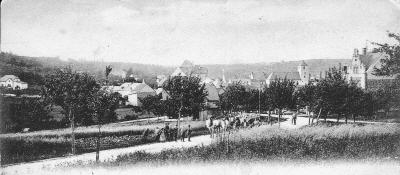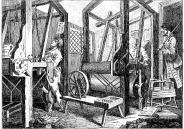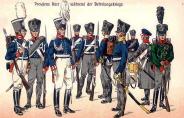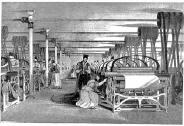An historic place

Dudeldorf on a late 19th century photgraph
The wool weaver's house is a building with a long history and if you are intrigued to know who lived in the house over the last several hundred years, I have done some research on the history of the building*:
The first traceable owner of the wool weaver’s house is Master Carl Brand who is indicated as the owner of the house in the cadaster of 1825. We believe that master Carl built the house over an existing property, financed from the revenues of his business. Carl seems to have been somewhat of a self-made man who belonged to a family of weavers that dominated the town of Dudeldorf in the 18th century.
In contrast with some of his less fortunate relatives – one of which lived with his family in the back of his building and whose remains are conserved today as part of the courtyard – Carl seems to have expanded his business. He controlled the whole wool making process, including even maintaining his own herd of sheep.
The weaving business was often threatened by the lack of wool as raw material which led to unstable market prices. His rank in the taxpayers’ list of 1784 was four places higher than his previous rank of 1782. Carl belonged to the upper middle class of the town being outranked mainly by the Lords of Dudeldorf, the mayor, the notary and the some of his own relatives.
Master Carl may have benefited from the fact that Dudeldorf’s wool weavers were specialized in producing cloth for military uniform garments. In the 18th and early 19th century the town changed hands several times and the subsequent Austrian, French and Prussian armies ordered cloth from the weavers in Dudeldorf. It is notable that they were specialized in cloth for the general troops, who proclaimed the product to be “itchy”. Military officers, on the other hand, had their uniforms made from imported Spanish Merino sheep wool.
Carl chose a prominent location for his residence and manufactory next door to the town’s physician and pharmacy and close to the Castle. He could enter the newly built Church portal directly from his backdoor. He added one additional story to his home overlooking his neighbors’ properties as a sign of his wealth.
Little more is known about the first owner of our wool weaver’s house. Court records of 1784 report that he participated with other prominent citizens in an demonstration against the town’s priest - who had exaggerated his right to fine people for religious offenses like swearing or cursing in public, being late or not attending Sunday mass, work on a holiday, etc.
According to the Court records the protestors shouted: “Listen citizens, who would remember that we ever had such a hungry shaveling[=priest] issuing tickets every day for so much money? We warn you citizens: you better pay before you get even more tickets.” This led the whole town - adults and children - to join in and to shout with them. The Court of Dudeldorf – located in the building which today is the Hotel- sentenced him and the other protest leaders to a severe fine of 10 Gold Dollars each (several months’ income) for “uprising against the public order”.
It is ironic that when Carl built the wool weaver house around 1790 as a sign of his wealth, he could not know that his business was already doomed to bankruptcy because of the invention of the Steam engine-run mechanical loom by Edmond Cartwright in England in 1785. This meant that the family-run weaving businesses were replaced by large factories during the 19th century and was therefore an investment in machinery that the Dudeldorf weavers could not cope with. Alas, the wool weaving industry disappeared completely.
This also marked the downfall for our Wool Weaver House. As a prominent building it changed hands several times and became the town’s butchery and later served as an inn. By 1935 the building was completely abandoned and the interior was torn out for its new use as barn and cow stables. In the early 1970's the building was bought by the City Council with the idea to convert it into fire station. Once this idea was abandoned, the Council wanted to tear the building down to make room for a parking lot. Fortunately, this was prohibited by the Bitburg County heritage protection authority. Another attempt to use the building as a civic center failed when the Council was able to buy part of the Castle and locate it there. Since then, the Council managed to sell the Wool Weaver House to an investor who later failed to obtain financing. The building had to be reverted to the Council and stayed there until I bought it in 2011 under the charge to restore the face of the building to its original state.
* The historic facts are taken from the book “Dudeldorf: Living conditions, Economy, demographic structures and residents until the middle of the 19th century” by Dr. Ernst Lutsch


